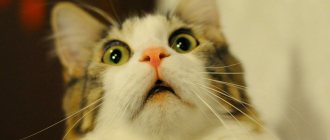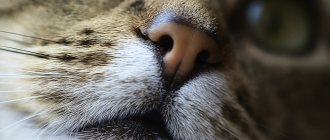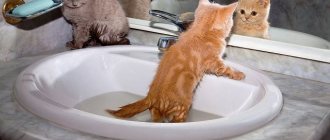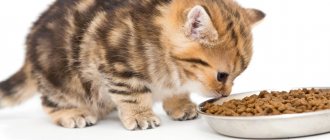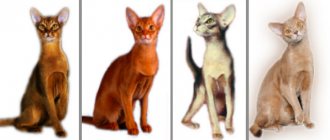14305Pavel
In order to determine how healthy a kitten is, it is very important for future owners and breeders to study the development of kittens week by week. How strong a kitten is, whether it needs additional stimulation of the immune system or care can be determined by recording changes in the development of kittens by day after birth. The correct growth of a small pet depends not only on a properly structured diet, upbringing and training, but also on compliance with the rules that are established for caring for kittens.
Features of development in the first week
Kittens develop especially rapidly in the days after birth. After birth, he weighs no more than 100 grams and gains about the same amount in the first week. Underweight or excess weight directly affects development, so you need to monitor it and regularly weigh your pet.
During the first 3 days of life, as a rule, the umbilical cord falls off, which the cat can care for independently. But in order to prevent the occurrence of inflammation, kittens are recommended to treat the umbilical cord in the first days of life with a weak solution of potassium permanganate.
A newborn kitten is always blind and begins to see only after three weeks from birth. Few people know such a feature as congenital deafness, which disappears only by 5 days after birth. A deaf baby does not even respond to his mother's voice.
It is especially important to arrange a place for the cat in advance so that small kittens during the period of deafness can easily find their mother . The development of kittens from birth occurs very rapidly; it is during this period that he receives his first food in the form of mother's milk, which ensures that all necessary microelements and nutrients enter the body. Natural nutrition is very important for the development of a kitten, since it also includes antibodies that the baby needs to form immunity.
© shutterstock
Although the baby does not see or hear in the first days of his life, he perfectly uses his sense of smell, with the help of which he identifies his mother. Kittens are born with a sense of smell that allows them to find a cat, even if it is within a radius of 60 centimeters from the kitten. In order to ensure the proper development of the kitten, it is necessary to prepare a place for the cat in which drafts and sudden changes in temperature will be completely excluded. This will not only protect the baby from colds, but also provide comfortable conditions for growth.
What are the norms for weight gain for kittens?
The first six months of a kitten's life are the most active in terms of growth. Accordingly, if the baby is healthy and develops normally, he will regularly gain weight:
- Before the baby turns 1 month old, he rapidly gains weight - about 15 g per day. At the same time, by the end of the 1st week, the kitten should double its birth weight. Weigh him daily during this period.
- From 1 to 2 months, weight gain occurs systematically, on average 100–150 g per week. Weigh the baby once every 3 days.
- After 2 months, weight gain varies from person to person. It depends on the breed and nutrition of the animal. He is weighed weekly for up to 6 months, then once a month for up to a year. It is important that there is weight gain. If it is absent, you should contact your veterinarian to find out the reasons.
Since there are no exact indicators of body weight gain (much depends on the individual characteristics of the animal, its living conditions and diet), the owner should focus on the average weight standards for kittens.
Table: average body weight of kittens in the first 6 months of life
| Age | Weight |
| 1–6 days | 70–130 g |
| 7 days | 85–200 g |
| 7–14 days | 225–400 g |
| 14–21 days | 285–500 g |
| 1 month | 500–750 g |
| 2 months | 1000–1500 g |
| 3 months | 1700–2300 g |
| 4 months | 2500–3600 g |
| 5 months | 3100–4200 g |
| 6 months | 3500–4800 g |
Short-term stabilization of weight in a kitten
The phenomenon of short-term weight stabilization often occurs. There is no need to panic if the kitten’s weight gain “frozen” for several days, and then continues in the same progression.
Such an anomaly can manifest itself at any time stage of the baby’s life. It often occurs when there is a transition from breastfeeding to regular food (dry food or natural food). This is due to the fact that the baby’s body goes through a period of adaptation to receiving new nutrients.
However, you should worry if there are no changes for more than a few days (for example, a week). This may mean that the kitten is malnourished or sick or infected with parasites. You should visit a veterinarian as soon as possible if, after weight stagnation, body weight begins to decrease rather than increase.
Table: kitten weights by month (values for popular breeds)
| Kitten age | Maine Coon cat weight (g) | Maine Coon cat weight (g) | British cat weight (g) | British cat weight (g) | Scottish cat weight (g) | Scottish cat weight (g) |
| Newborn kitten | 120–140 | 120–160 | 60–140 | 70–140 | 60–140 | 70–140 |
| 1 Week | 180–230 | 200–260 | 110–250 | 240–260 | 110–250 | 240–280 |
| 2 week | 280–340 | 400–360 | 150–360 | 340–400 | 140–360 | 340–400 |
| 3 week | 420–550 | 440–600 | 210–420 | 400–630 | 200–420 | 390–630 |
| 4 week | 560–680 | 630–750 | 250–600 | 550–740 | 240–600 | 540–740 |
| 2 months | 1100–1400 | 1200–1500 | 450–900 | 1000–1700 | 400–900 | 1000–1700 |
| 3 months | 1700–2300 | 1800–2300 | 1000–1500 | 1500–2500 | 1000–1500 | 1500–2500 |
| 4 months | 2700–3600 | 3000–3800 | 1700–2400 | 2100–3900 | 1700–2400 | 2100–3900 |
| 5 months | 2900–3900 | 3000–5500 | 2200–2900 | 2600–4300 | 2200–2900 | 2600–4300 |
| 6 months | 3200–4000 | 3900–6000 | 2300–3600 | 3000–5400 | 2300–3600 | 3000–5400 |
| 7 months | 3500–4100 | 4200–6500 | 2400–3900 | 3300–5600 | 2400–3900 | 3300–5600 |
| 8 months | 3800–4300 | 4500–6900 | 2500–4100 | 3500–6000 | 2500–4100 | 3500–6000 |
| 9 months | 4100–5000 | 5000–7000 | 2500–4300 | 3800–6400 | 2500–4300 | 3800–6400 |
| 10 months | 4200–5500 | 5200–7700 | 2500–4400 | 4100–6700 | 2500–4400 | 4100–6700 |
| 11 months | 4300–6000 | 5700–8000 | 2500–4500 | 4300–6800 | 2500–4500 | 4300–6800 |
| 12 months | 4500–6300 | 5700–9000 | 2500–4600 | 4500–7000 | 3500–4600 | 4500–7000 |
How to determine weight standards for a mongrel kitten
When it is not possible to determine what breed a kitten is, it is necessary to use average indicators. The size of the baby will change in accordance with its development. There are a number of factors that allow you to predict a kitten’s weight gain. For example, when he switches from breast milk to a normal diet, the weight may decrease slightly.
After the 6th month of life, weight gain is not of decisive importance. If the cat is active, eats well, and has no problems visiting the litter box, then there is no need to worry too much. The veterinarian should be observed on a schedule determined by the doctor (basically it coincides with the vaccination schedule).
Having mongrel cats and a dog adopted from the street, I regularly visit the veterinarian. All my animals have veterinary passports, are vaccinated and sterilized. This way I protect not only them, but also my family. After all, some diseases (and at least the same worms) can be transmitted to humans. Since my children play with animals, I have a strict order in this matter.
Development over 2 weeks
During the second week of his life, the baby grows and develops, which is reflected in his indicators:
- weight increases to 250 grams;
- the auricle, which was poorly developed before this age, is fully formed and the kitten begins to respond to extraneous noises, as well as the cat’s meow;
- by the end of the second week, the eyes may open;
- communication skills improve, and kittens begin to communicate not only with each other, but with their mother, which affects their development.
During this period, breeders and owners of kittens allow them to be picked up without fear that the cat will abandon her babies. However, the development of even a healthy baby cannot guarantee a sufficiently strong skeleton at this age, so you need to handle them carefully and without causing them additional inconvenience.
A feature of the psychological development of kittens at this age is that they urgently need not only the attention of the cat, but also communication with their brothers. After all, it is in the first month of life that the baby’s character and his ability to establish contact are formed.
Before 3 weeks, it is not recommended to look at the kittens very often and often pick them up. This can affect the psychological development of small pets, and the cat may behave aggressively, thus showing protection.
Your kitten: newborn
- Physical development : Newborn kittens have their eyes closed and ears folded. They will have no teeth, and their gums, nose and paws may be bright pink. They do not yet have a gag reflex or the ability to thermoregulate. The umbilical cord will be attached and fall off on its own between 4 and 5 days of age. The claws will not extend. At this age they can neither hear nor see; they can navigate the world around them only by smell and by seeking warmth and comfort.
- Behavioral Development : Newborns will sleep most of the day. Newborns cannot defend themselves or walk, but can move around by crawling. A healthy newborn will squirm and meow when picked up.
- Average temperature : 35-36 ℃ at birth. It is important to provide a gentle heat source to keep the kitten warm and stable. The kitten's ambient temperature should be between 30-32 degrees Celsius at this time.
- Average weight : 50-150 grams
- Care Information : Newborn kittens are with their mother at all times, as mothers will provide food, cleaning, warmth, and bath support. If the mother is not present, they should be bottle-fed and kitten formula every two hours under the supervision of knowledgeable persons, encouraged to go to the toilet, and maintained at an appropriate temperature.
© shutterstock
Development in the third week
During the third week, all kittens' eyes open. However, vision is not yet good enough to navigate in space. It is necessary to monitor all physiological changes to ensure that the development of kittens corresponds to their age and to promptly eliminate irritating factors that may interfere with normal growth.
The main stages of development of newborn kittens take place in the first three weeks, as their body is actively growing and all the organs of smell and touch are formed. It is at the age of three weeks that kittens first try to stand on their paws and their teeth appear.
© shutterstock
The formation of the jaw will take up to two months. From the third week, you can safely accustom the baby to your hands, constantly play with him and stroke him, and in order to let the pet know that the owner is also one of his friends, in addition to the other kittens and the mother.
Deviations in the development of a kitten
Causes of developmental disorders
There are exogenous and genetic malformations. Exogenous ones are caused by the influence of external factors, and genetic ones are caused by a violation in the animal’s chromosomes.
Malocclusion in an animal is one of the genetic anomalies
Environmental factors have a huge impact on the development of animals. If the kitten was born healthy, then any ailment is most likely due to external influences.
Signs of developmental disorders in kittens
Chamomile decoction will help cope with digestive problems
Development at 5-6 weeks
During this period, it is recommended to carry out the following activities:
- show it to a veterinarian for the first time, who will record the level of development and prevent developmental delays;
- The baby should be actively transferred to artificial nutrition and given no more than 100 grams of wet food daily;
- organize your own place for each of the kids;
- show kittens to direct buyers or purchase a baby by booking it in advance at the nursery.
During this period, it is recommended to organize six meals a day, which will include no more than 100 grams of food per meal. Such nutrition will allow the baby to correctly go through all stages of kitten development and become sufficiently strong. It is recommended to be attentive to the prevention of various parasites and carry out timely vaccination and deworming.
Why monitor the development of newborn kittens?
Observation of physiological changes is necessary to assess whether the kitten's development is appropriate for its age. This way the owner can promptly respond to negative factors that interfere with normal growth.
The main distinguishing points to determine the age of a kitten:
- the presence of an umbilical cord,
- Are the eyes open, what color are they,
- ears raised or flattened,
- condition of teeth (deciduous, changing, molars),
- the presence of wool and undercoat,
- how much time does he spend in an active state?
In the third month from birth
As a rule, at this age, all processes slow down a little and the main focus is on adapting to a new home. From three months the baby's character begins to emerge. Also during this period, the baby becomes completely independent, responds to his nickname and does not need the constant presence of his mother.
He learns to build relationships with his new owner and adapts to living conditions . Considering that at this age your pet will be quite inquisitive, you should limit its access to all dangerous places in the house, including electrical appliances. At the end of 3 months, it is recommended to carry out repeated deworming.
The diet during this period must be fully formed and established, and the owners must decide what type of food they will prefer for their baby: natural food or dry or wet food.
Your kitten: 8 weeks
- Physical Development : All baby teeth will appear by 8 weeks of age. The eyes will completely change to their adult color - green, yellow, brown or blue. The ears will be proportional.
- Behavioral Development : Eight week old kittens will be energetic and independent. Their agility and coordination will be almost fully developed.
- Average temperature : 37-38 ℃. At this age, a heat source is no longer required if the environment is at a comfortable temperature of 21-23 degrees.
- Average weight : 850-950 grams.
- Care Information : Kittens should be fed canned and dry kitten food three to four times daily and can get the bulk of their calories from dry food if they choose. Always provide access to water and a shallow litter box. If two weeks have passed since the first FVRCP vaccine was administered, kittens can receive a booster vaccine at this time. If the kitten has not been dewormed, a dewormer can be administered. It's also a good idea to do a stool test to check for internal parasites. At this age, if they weigh about a kilogram and are healthy, they can be spayed/neutered, microchipped and adopted.
Development from the fourth to the sixth month
During this period, it is recommended that he trim his claws for the first time; it is necessary to monitor the following indicators:
- height, which will depend on breed and gender;
- weight, which must be at least 1.4 kg;
- constant activity and good socialization.
Until six months, it is not recommended to give the baby food that is intended for adult cats, as it will not provide the necessary development and the intake of all necessary microelements.
Up to six months, it is recommended to adhere to five meals a day, which ensures good functioning of the gastrointestinal tract and stable development of your kitten. At the end of 6 months, the baby's teeth will begin to change. This age is most optimal for castration. It is advisable to carry out a third deworming in order to eliminate the presence of parasites in your pet’s body. In the sixth month, it is recommended to switch the baby to three meals a day, which corresponds to his level of development.
© shutterstock
What can a kitten weigh at birth?
The weight of a kitten at birth can depend on various characteristics:
- Gender. At the moment of birth, a cat may not differ in weight from a female cat, but this difference becomes noticeable after some time. Males are usually a little larger than female cats, and therefore weigh a little more.
- Number of kittens born. It has long been noted that the more numerous the litter, the greater the underweight of each individual.
- The completeness of the diet of a mother cat during pregnancy.
- Belonging to a certain breed. For example, a Maine Coon kitten at the time of birth will weigh more than a baby, for example, of the Siamese breed.
Newborn kittens of large breeds (for example, Maine Coons) will weigh more than their graceful relatives
A newborn kitten most often weighs no more than one hundred and twenty grams. He is still blind and mostly immobilized. All he can do is eat, grow and get enough sleep. Staying in this mode, the baby can gain up to 15 grams per day.
Development from 9 months to a year of life
During this period, the kitten is fully formed, its development is almost complete, and it continues to turn into an adult pet, increasing in size and gaining weight.
At 10 months of age, you can start switching your baby to adult food. However, this must be done gradually, mixing it with baby food.
Timely trimming of nails and dental care, as well as visits to the veterinarian will ensure the correct development for your baby and will allow you to adjust your upbringing and diet so that your pet grows healthy, active and receives all the necessary care.
Stages of kitten development by month
The stages of growth and maturation of a kitten, from the moment of birth to one year, are associated with certain patterns. All kittens go through the same stages of development over the course of days and months.
First week
Kittens are born with their eyes closed and hear almost nothing. They are covered with light fluff; the most important thing for them during this period is warmth and milk.
In the first weeks, kittens' immune systems are largely supported by mother's milk. It provides their body with the proteins necessary for development. The weight of newborn kittens rarely exceeds 100 grams; within a week they gain weight from 10 to 30 grams per day.
Most of the day, approximately 90% of the time, kittens sleep. They move only to crawl to the cat for milk and warmth. If they are cold or want to eat, they call the cat with a loud squeak.
Kittens are born with primary reflexes
Observing the development of small kittens day by day, it can be noted that on days 5-8 kittens develop hearing. Since kittens are just learning to respond to sound, the room where they are should be relatively quiet.
After the 5th day of life, the umbilical cord dries out in kittens. The cat should constantly lick the cubs, giving a tummy massage, which helps stimulate the intestines.
There should be no drafts in the room where the cat and newborn kittens are located. If it is very cold, you can put a heating pad in the bed. Young kittens are very vulnerable to disease and infection.
Second and third weeks
On days 7-10, the eyes open. The process can take 2-3 days - at first there are narrow slits through which only the outlines of objects can be distinguished. The eyes are cloudy, blue and covered with a film. The eyes open completely by the 14th day.
Kittens' eyes open at 7-10 days
The speed of eye opening depends on several factors:
- by breed;
- from gestation period;
- on the health status of the mother and kittens.
In most cases, short-haired breeds develop faster than long-haired ones, and Oriental cats develop much faster than other cat breeds. For example, sphinxes (Canadian, Don) are often born with their eyes already slightly open, and on the 2-3rd day the eyes open completely. Siamese, Thai and Cornish Rex cats become sighted on days 3-6, Siberian and Persian cats on days 5-9, and British cats on days 6-10.
Another indicator is the gestation period of the kittens. If kittens are born at 68-71 days, then perhaps they will be born with their eyes already open, or will open them in a much shorter time.
If the kittens are healthy, eat well, and the cat devotes enough time to them, then the eyes, as a rule, open in a timely manner. A delay may indicate that the mother cat has some kind of virus, or that the kitten has developmental disorders. If more than 10 days have passed and the eyes are still closed and there is some discharge from under the eyelids, you need to consult a veterinarian.
In 2-week-old kittens, the fur grows and becomes thicker, and the undercoat begins to grow. At this age, kittens' susceptibility to temperature changes decreases, however, they are still vulnerable. The kittens' weight doubles. They hear much better, but still have difficulty identifying the source of sound.
A kitten at the age of 3 weeks continues to actively gain weight; its vision is not yet so sharp, so when it crawls, it can bump into objects. In the third week, the kittens make their first attempts to get out of the bed. During this period, baby teeth begin to emerge.
Three-week-old kittens begin to move actively
Kitten at 1 month
At 4 weeks of age, kittens begin to interact more and lick each other's fur. They begin to actively run, play, and adopt the skills of their mother. At this time, you can place a tray next to the bed on which the kittens sleep so that they begin to get used to it.
By the age of one month, the kitten has 26 milk teeth and sometimes bites the cat's nipple, causing pain. If maternal feeding stops by the age of one month, it is advisable to purchase a cat's milk substitute, since the kitten's body is not yet fully formed. At this stage, complementary foods and clean water are also introduced into the diet.
The bones of one-month-old kittens become stronger, they can already be picked up, stroked and played with more often so that they begin to get used to the person and his smell. This is also a good time to prevent worms.
By the age of one and a half months, the kitten already knows how to wash itself, hunt, go to the litter box, and eat solid food. At this time, you can purchase a scratching post, as the kitten begins to produce sharp claws.
Development of a kitten from birth to 1.5 months
Kitten at 2 months
Upon reaching the age of 2 months, kittens usually stop receiving mother's milk and switch to self-feeding.
At 2 months, kittens’ vision is fully formed, hearing and sense of smell are well developed. The kittens' eyes cease to be cloudy and acquire their natural shade. However, there are specific breeds in which the eye color does not change, for example, Siamese, Thai, Polynesian and British breeds.
The fur changes color intensity, the pattern appears, the lines become clear. This happens slowly and gradually, and therefore is not immediately noticed by others.
During this period, the kitten should be shown to a veterinarian for the first time, who will record the level of development and health status of the animal. At the age of 2.5 months, the kitten must receive its first vaccinations against viral diseases. The second vaccination is given after 3-4 weeks.
Two months you need to take the kitten to the veterinarian for examination and vaccination
Kitten at 3 months
In the third month of life, all processes begin to slow down a little, and the kitten’s character begins to emerge. He becomes completely independent and responds to his nickname.
A three-month-old kitten has a well-developed musculoskeletal system; he already knows where the bowl is and where the tray is. At this age, the kitten becomes faster and bolder. He is actively exploring his home, so it is necessary to ensure his complete safety. You should protect the kitten from chemicals, detergents, medications, poisonous plants, remove small objects - needles, pins, push pins, close electrical outlets.
A booster vaccination can be given at 12 weeks of age. At this time, it is also necessary to carry out repeated deworming, provided that it was first carried out at the age of 4-6 weeks.
By 3.5 months, the kitten’s character has already been formed, it sees and hears excellently, eats natural or industrial ready-made food, and goes to the litter tray. You can already visually distinguish a cat from a cat.
If you plan to give away or sell a kitten, then the age of 3-3.5 months is an ideal option for changing the owner.
You need to play with a small kitten every day
Kitten at 4 months
At 4 months, a kitten is already considered a teenager. During this period, his claws are trimmed for the first time and he is taught all hygiene procedures. To maintain proper development, you need to spend as much time as possible playing with the kitten; it is recommended to pick it up more often, show care and groom it daily so that the kitten feels comfortable when communicating with a person.
Milk teeth in kittens begin to change to molars; this happens gradually and often unnoticed by the owner. Kittens swallow most of their baby teeth with food.
At 4 months, a kitten needs to have its nails trimmed for the first time.
Kitten at 5 months
At 5 months, the kitten’s appearance gradually changes, its body increases in size, its muzzle and tail lengthen, its legs stretch. He already looks more like an adult cat, he is less interested in toys, he sleeps more and strives to communicate with people.
Sixth month of life
At the age of 6 months, the kitten reaches its adult size. Most kittens begin puberty during this period. The timing of puberty can shift from 4-5 months to 11-12 months of age. Puberty is affected by:
- Breed. Siamese, Thai, Burmese, and Oriental varieties ripen earlier.
- Season. In cats that reach 4-6 years of age in the spring and summer, puberty occurs earlier than in cats of the same age in the winter months.
- Maintenance and nutrition. Comfortable conditions and regular nutritious food help the pet mature faster.
- Habitat. Cats living with other adults of both sexes mature earlier than cats living in a city apartment.
At approximately 6 months, kittens begin puberty.
When a kitten reaches puberty, hormones change its behavior. The cats behave restlessly and rush around the apartment. Cats may become more aggressive. For this reason, it is important to consider spaying and neutering cats.
If offspring are undesirable, then girls should be sterilized at 6-8 months, boys should be castrated at the age of six months to a year. After the operation, the kitten’s body produces fewer sex hormones, and the animal loses the ability to reproduce.
If you decide to get offspring, then you should remember that physical and puberty are not the same thing. Regardless of the timing of puberty, the kitten’s physical maturity occurs no later than 10-12 months of age. It is during this period that you need to plan your first mating.
Kittens at 7-8 months
At 7 months, in autumn-winter, kittens begin their first molt. Because kittens lick themselves frequently during shedding, a large amount of hair accumulates in their stomach. To prevent this process, it is enough to regularly comb the coat with a soft brush.
Brush your kitten's fur regularly
From the age of 8 months, kittens practically do not gain weight, their growth does not noticeably increase. They have established habits. The characteristics of temperament are clearly visible.
Development from 9 months to 1 year
At 9 months, the kitten is fully formed, its development is almost complete, and it continues to grow into an adult, increasing in size and gaining weight. By this time, the regime has stabilized, the pet finds time to sleep and play.
At 10 months, a kitten is considered sexually mature. But mating before a year should not be carried out. The size of the cat at this time is already significantly larger than the size of the cat; these differences can be more than 1 kg.
At 11 months, most kittens stop growing. At 12 months, the kitten already looks like an adult animal. By this time, it is necessary to complete all vaccinations during the first year of life, castrate or sterilize, and switch to food for adult animals.
Common Misconceptions
On the Internet you can find many myths and misconceptions related to the process of “repainting” cat eyes. Here are just a few of them:
- All newborn kittens must have bright blue eyes. Some believe that deviations from this “norm” threaten serious pathologies. In practice, it happens that kittens’ eyes can be colored in different gradations of gray and blue colors... And all this is the norm. If the iris of a recently born kitten is not blue, this is not a pathology!
- There is a common misconception about the correlation between coat color and eye color. This opinion is partly true. But only for representatives of certain breeds whose coat color was “tied” to the color of the iris during a long and difficult selection process. It’s just that in their case, the eye color can actually be anything, and this is also not considered a deviation.
- Some breeders are truly convinced that eye color depends on... diet. But this “theory” is absolutely not confirmed either by science or by practical observations of breeders. It is known, however, that frequent feeding of fish can cause a cat’s fur to noticeably darken, but even in this case, its eyes will not change color.
We invite you to read: What types of discharge can occur in cats after giving birth and when treatment is required
Why do newborn kittens have blue eyes and how eye color changes
To understand exactly how the change in eye color in kittens works, you need to start with the very development of the kitten in the womb. Already at the initial stages, 34 pigment centers are localized in the embryo, from which the pigment, during the growth and development of the kitten, moves mostly to the hair follicles and accumulates there. There is negligible amount of it in the iris.
The most interesting thing is that the pigment continues to accumulate after birth, which is why the color of the kittens’ eyes changes.
But why do all newborns have blue, gray-blue or blue eyes? It's all about the amount of pigment (melanin) - it is known that the less pigment, the lighter and cooler the eye shade. At the time of birth there is little of it in the iris. This is the reason why all babies have cool blue or light blue eyes.
There is no pigment in the eyes of newborn kittens, so they have blue eyes.
Actually, what final eye color a kitten will have is determined by a set of genes inherited from the parents to the baby. It is responsible for the amount and presence of pigment in the eyes and the speed of its movement there. This is what determines when the eye color changes and what it will be like.
The cat's iris is divided into two layers: the upper one is the stroma and the lower one is the epithelium. It is the amount of melanin in the stroma that is responsible for eye color. If there is a lot of it, then the color will be brown or copper, if less - green, if very little - blue or cyan.
With a probability of at least 50% you can predict what eye color a kitten will have if you look at its parents
Eye color standards
Each breed has a personal accepted standard for eye color. These are quite strict rules that should not be broken.
So, which breeds have strict restrictions on eye color:
- Abyssinian cat. This breed can only have green or yellow eyes.
- Burmese cat. This beauty's eyes can only be light gold.
- Burmilla. Green of any intensity.
- Balinese. Blue or blue eyes.
- Bombay cat. Only deep copper eye color.
- Burmese cat. Exceptionally bright blue eye color.
- Havana brown. Green or yellowish-green.
- Egyptian Mau. The eyes are light green (gooseberry color).
- Korat. Amber or amber-green eyes.
- Kao-mani. Yellow or blue eyes.
- Lykoy. Yellow or amber eyes.
- Nibelung. Only gooseberry eye color.
- Oriental cat. Green eye color is preferred.
- Ojos azules. Only blue eyes.
- Pixie bob. The eyes are gooseberry-colored, brown or yellow.
- Russian blue cat. Exceptionally green eyes, from light to rich emerald.
- Ragdoll. Only blue eyes.
- Siamese cat. Blue or blue eyes.
- Tonkinese cat. Aquamarine, blue or yellow eye color.
- Thai cat. Only deep blue eye color.
- Turkish van. Only gold or blue.
- Chausie. Yellow, copper, hazel or green eye color.
- Chartreuse (Carthusian cat). Copper, orange or amber eyes only.
The standard of some cat breeds allows them to have only a certain eye color (pictured are Havana Brown cats)
In some breeds, eye color may depend on coat color:
- British cats of the black solid, blue solid, cinnamon, fawn, and lilac colors cannot be green-eyed or blue-eyed.
- British Chinchillas and British Goldens can only have green eyes.
- White Turkish Angoras can only be blue-eyed, green-eyed, or yellow-eyed.
- In Oriental cats, yellow and blue are allowed in solid (solid) colors and blue in color-point colors.
Some interesting facts about eye color in cats:
- A Sokoke cat can change eye color depending on its mood.
- Very often, blue-eyed cats (especially white ones) are deaf.
- All cat lovers know that the blue-eyed gene in purring cats is recessive. However, in cats of the Ojos Azules breed, this gene somehow mutated into a dominant one. They can also be green-eyed or yellow-eyed. Also, deafness is not associated with the Ojos blue-eyed gene and they cannot be bred with other blue-eyed cats.
- All color-point cats can only be blue-eyed or blue-eyed. Their eyes absorb all colors of the rainbow spectrum except blue. They reflect it and therefore appear blue-eyed. But the brightness of blue depends on the amount of pigment: the more pigment there is, the paler the color of the cat’s eyes. In very rare cases, Color Points may have yellow eyes.
- If a cat has no pigment in her eyes, she will be red-eyed. This only occurs with albinism.
- Albinos can also have blue eyes (this is called partial albinism).
- As surprising as it may sound, outbred cats usually have much richer eye color than many purebred cats.
Abyssinian cats most often have green eyes
Popular misconceptions about changing eye color in cats
On many forums where inexperienced breeders begin to advise cat lovers on how to care for them, incorrect information comes across. Popular misconceptions about eye changes in cats include the following facts :
- All kittens, without exception, initially have a blue-gray tint to their eyes.
- There is a relationship between fur color and iris color.
- The color of the iris depends on the kitten's diet.
Each of these theories has no scientific proof. But despite this, breeders are taking measures to breed cats with exactly the eye color that is becoming the standard.


